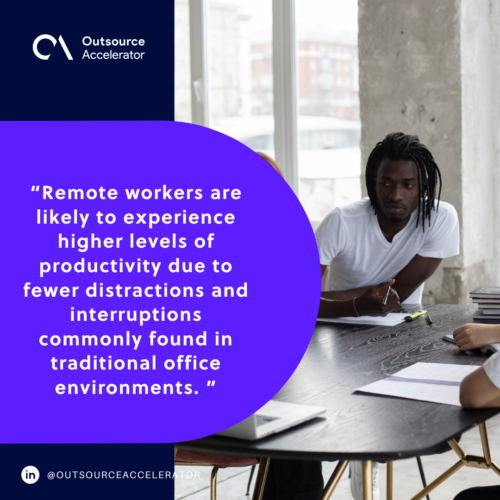Remote collaboration: Advantages, challenges, and tips

The ability to unite teams across geographical boundaries and time zones has revolutionized how teams operate and communicate. Remote collaboration transcends traditional office spaces, offering unprecedented flexibility and efficiency.
As technology continues to evolve, so too does how we work together. Mastering the art of remote collaboration has become essential for staying competitive in today’s digital era.
This article examines the intricacies of remote collaboration, including its advantages, challenges, and strategies for success in a globally connected world.
What is remote collaboration?
Remote collaboration is when individuals or teams work together on projects, tasks, or initiatives while being physically located in different geographical places. It requires them to use various digital tools and technologies, such as the following:
- Video conferencing
- Project management software
- Document sharing platforms
Remote collaboration has become increasingly prevalent, especially with the rise of remote work opportunities.
Outsourcing firms like Sourcefit rely heavily on remote collaboration practices to deliver excellent service.

Advantages of remote collaboration
Remote collaboration brings several benefits, including:
Flexibility
Remote collaboration allows individuals to work from anywhere, whether it’s from home, a coffee shop, or while traveling. This flexibility in location enables employees to create a work environment that suits their preferences and enhances their productivity.
Work-life balance
Remote collaboration offers employees greater flexibility in managing their work schedules. This allows them to better balance their professional responsibilities with personal commitments and interests.
An improved work-life balance can lead to higher job satisfaction and overall well-being.
Access to a global talent pool
By breaking down geographical barriers, remote collaboration enables organizations to tap into the global talent pool. They get access to a broader range of skills and expertise since they are not restricted to hiring locally.
To make remote hiring much easier, consider collaborating with trusted outsourcing firms like Remote Employee.
Cost savings
Remote collaboration can lead to significant cost savings for businesses. It reduces expenses associated with office space, utilities, and commuting allowances.
Increased productivity
Remote workers are likely to experience higher levels of productivity due to fewer distractions and interruptions commonly found in traditional office environments. They have greater freedom to select a setting that is more conducive to creativity and productivity.
Remote collaboration also allows people to structure their workday in a way that optimizes their focus and energy levels.

Challenges in remote collaboration
Although remote collaboration brings several advantages, businesses must also be aware of these challenges:
Communication barriers
Communication is a crucial aspect of collaboration. The lack of physical proximity in remote collaboration can make it difficult to establish and maintain effective communication channels.
Misinterpretation of tone, delays in response times, and difficulty conveying complex ideas can all hinder collaboration.
Building trust in a virtual team
With remote collaboration, the lack of face-to-face interaction can make it challenging to build trust and rapport between team members.
This can lead to feelings of isolation, decreased team cohesion, and difficulty in maintaining accountability.
Time zone differences
When team members are located in different time zones, coordinating meetings, discussions, and project deadlines can become complicated.
This can result in delays in decision-making and decreased real-time collaboration for team members working outside regular business hours.
Technical difficulties
Remote collaboration is heavily dependent on technology. However, this dependence introduces the risk of:
- Technical glitches
- Internet connectivity issues
- Software compatibility issues
These challenges can disrupt workflow, cause frustration, and hinder productivity.
Collaboration fatigue and burnout
Remote work can blur the boundaries between work and personal life, increasing the risk of collaboration fatigue and burnout.
Without physical separation between work and home environments, individuals may struggle to disconnect from work-related tasks. This can result in decreased motivation and well-being.
7 strategies for successful remote collaboration
To ensure successful remote collaboration, you may implement the following strategies and tips:
1. Establish clear communication protocols
Set up clear communication modes and guidelines for remote collaboration.
Define preferred modes of communication, such as:
- Chat
- Video calls
In order to keep team members informed, promote open communication, and give frequent updates.
2. Cultivate trust and camaraderie
Encourage team members to get to know each other beyond work-related matters. You can foster a sense of trust and camaraderie through:
- Virtual icebreakers
- Regular check-ins
- Team building activities
- Opportunities for informal communication
Encourage open dialogue, empathy, and mutual support to strengthen team cohesion.
3. Set clear goals and expectations
Clearly define project goals, roles, and responsibilities to align team members’ efforts. Ensure everyone understands what is expected of them and establish realistic timelines and deadlines.
4. Utilize collaborative tools and technologies
Invest in and implement reliable technology tools that facilitate remote collaboration. These include:
- Project management software
- Document sharing platforms
- Video conferencing tools
Choose user-friendly, secure, and scalable platforms to meet your team’s needs. monday.com is one perfect example of a reliable collaboration tool that covers all these key elements.
Remember to provide necessary training and support to ensure everyone can effectively use these tools.
5. Establish regular check-ins
Schedule regular team meetings to keep everyone aligned and updated on progress. This helps maintain accountability and allows for quick problem-solving and decision-making.

6. Lead by example
Demonstrate effective remote collaboration practices as a leader. Communicate transparently, actively participate in collaborative activities, and foster a culture of inclusivity and respect.
7. Encourage feedback and continuous improvement
Create a culture of feedback where team members feel comfortable providing constructive feedback and sharing insights for improvement.
Regularly solicit input from team members and incorporate feedback into processes and workflows.
Remote collaboration offers unprecedented flexibility, accessibility, and efficiency in today’s interconnected world.
Embracing these remote collaboration practices helps facilitate seamless teamwork. They empower individuals to thrive regardless of geographical boundaries.







 Independent
Independent




